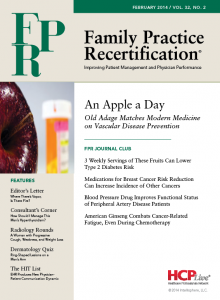Publication
Article
Family Practice Recertification
American Ginseng Combats Cancer-Related Fatigue, Even During Chemotherapy
Author(s):
A 2,000 mg dose of high-quality American ginseng is effective as a treatment for cancer-related fatigue, though it may be better at preventing the condition.
Frank J. Domino, MD
Review
Barton DL, et al. Wisconsin Ginseng (Panax quinquefolius) to improve cancer-related fatigue: a randomized, double-blind trial. J Natl Cancer Inst. 2013 Aug 21; 105(16):1230-8. http://jnci.oxfordjournals.org/content/105/16/1230.abstract.
Study Methods
This placebo-controlled, randomized control trial (RCT) evaluated the efficacy of a 2,000 mg daily dose of American ginseng in preventing and treating cancer-related fatigue (CRF).
Adult men and women with CRF — defined as a score ≥4 on an 11-point scale, where a score of 0 meant no fatigue and 10 meant the worst fatigue possible — were recruited for participation. With the exceptions of brain cancer and central nervous system (CNS) lymphoma, all types of cancer were included in the study.
Prior to their enrollment, all participants must have been diagnosed with cancer within the last 2 years, and their fatigue must have been present for 1 month or longer. Subjects were excluded from the RCT if they displayed any significant pain or insomnia ratings or received systemic steroids, opioids, prior or current ginseng, or other agents for which fatigue was the cause. All non-cancer-related causes of fatigue were ruled out.
A total of 364 subjects were enrolled from 40 sites, most of which were community health centers. The participants were evaluated prior to initiation and afterwards through the 5-point Multi-Dimensional Fatigue Symptom Inventory Short Form (MFSI-SF), and secondary outcomes were measured through the profiles of mood states (POMS) survey with fatigue-inertia and vigor-activity subscales. All of this data was collected at baseline and weeks 4 and 8, and side effects were collected through self-report.
The American ginseng obtained for this study was evaluated for quality and potency to the degree of containing 3% ginsensosides.
Patient Demographics
Each study arm was well-balanced, as there were no statistically significant differences in demographic features or fatigue scores among the subject groups.
Results and Outcomes
Of the participants, 78% completed all of the study interventions.
The primary endpoint of change in MFSI-SF at 4 weeks from baseline was not statistically different between the intervention and the placebo group, though it did show a trend for a difference. At 8 weeks, there were statistically significant improvements in fatigue and the POMS fatigue-inertia scales among those receiving ginseng compared to placebo (P= 0.003).
When the analysis was repeated from the perspective of active cancer treatment versus completed treatment, the subjects who were actively undergoing chemotherapy while taking ginseng showed statistically significant improvement in fatigue at 4 and 8 weeks, compared to those in the placebo arm.
Side effects were not statistically significantly different between the ginseng and placebo groups, though some uncommon symptoms included agitation, anxiety, insomnia, nausea, and vomiting.
Conclusion
This study supports the use of American ginseng at a daily dose of 2,000 mg in patients with CRF, especially when they are undergoing active cancer treatment.
Commentary
Ginseng has been touted as an herbal remedy for many diseases. Moderate-level evidence supports the plant’s mild benefit in the prevention of upper respiratory tract infections (URTIs), reduction of URTI symptoms, and potential improvement in mental performance.
While ginseng’s ability to treat fatigue in a variety of conditions has long been suggested, this RCT is the largest and most impressive study to address its use in CRF. A 2,000 mg dose of high-quality ginseng was deemed effective as a CRF treatment, though it may be better at preventing the condition.
The weaknesses of the RCT include that the evaluation was only continued through 8 weeks of treatment, so long-term data on the efficacy of ginseng in CRF is still lacking. The study’s clinical applicability is also a challenge, as it used high-quality ginseng even though no method to determine the quality of the ginseng that is accessible to the general public is currently available. In addition, ginseng’s mechanism of action is unclear, though it may involve the plant’s anti-inflammatory properties and/or be related to its influence on the hypothalamic-pituitary-adrenal axis.
While very few healthcare interventions have no side effects, ginseng treatment produced no significant adverse outcomes in this study. In addition, the RCT found no adverse interaction among ginseng and most chemotherapeutic agents, and it even hinted at ginseng acting synergistically with some agents.
Although ginseng is not currently regulated by the US Food and Drug Administration (FDA) and standardization issues remain for the plant, this study seems to support its use in both the prevention and treatment of CRF in cancer patients undergoing chemotherapeutic treatment.
About the Author
Frank J. Domino, MD, is Professor and Pre-Doctoral Education Director for the Department of Family Medicine and Community Health at the University of Massachusetts Medical School in Worcester, MA. Domino is Editor-in-Chief of the 5-Minute Clinical Consult series (Lippincott Williams & Wilkins). Additionally, he is Co-Author and Editor of the Epocrates LAB database, and author and editor to the MedPearls smartphone app. He presents nationally for the American Academy of Family Medicine and serves as the Family Physician Representative to the Harvard Medical School’s Continuing Education Committee.

2 Commerce Drive
Cranbury, NJ 08512
All rights reserved.





